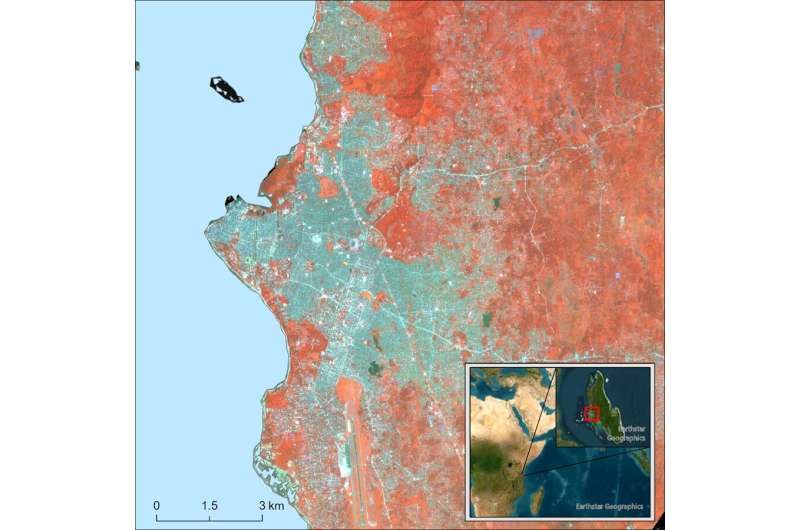This 3m resolution, multispectral image of Zanzibar City, taken from the PlanetScope satellite constellation, emphasizes the near-infrared wavelength of light that can distinguish between built-up urban areas (blue) and vegetated, open areas (red). Credit: Wolfgang Alders
At the U of A's Center for Advanced Spatial Technologies, Wolfgang Alders, a National Science Foundation SBE Postdoctoral Fellow, is using satellite imagery and archaeological methods to better understand the origins of urban life on the eastern African Swahili Coast, a vast region spanning the modern countries of Somalia, Kenya, Tanzania and Mozambique.
He has published two articles on the topic, one in the Journal of Archaeological Method and Theory and an earlier study in the Journal of Computer Applications in Archaeology.
Urban societies there have a long and storied history going back more than a millennium, with evidence for long-distance trade links as far away as Botswana, Egypt, India and China.
Alders works in the rural areas around Zanzibar City, a rapidly growing modern city with ancient roots. Continuously occupied for almost 1,000 years, Zanzibar City's old town, now a UNESCO World Heritage Site, has features reflecting its cosmopolitan origins as a mercantile hub between Africa and the Indian Ocean world.
During his time as a postdoc at CAST, which is based in Fulbright College of Arts and Sciences, Alders has been able to extend his scholarly network, train in advanced applications of drone mapping and learn the ins and outs of processing and applying multispectral (detecting more than the visible bands of light) satellite imagery for archaeological applications.
Using this high resolution satellite data, Alders is investigating environmental factors such as soil, geology and topography that conditioned urban origins and development in Zanzibar. But satellite imagery also helps address an increasingly common archaeological problem—carrying out archaeological surveys in modern city landscapes, where rapid growth is quickly obscuring archaeological evidence for ancient settlement.
This is a key challenge for archaeologists in the 21st century.
Modern urban populations are expected to increase from 55% to nearly 70% of the earth's population by 2050, with much of that growth occurring in Africa. The classical stereotype of the archaeologist is an explorer in a remote environment, but the reality is that urban expansions will soon cover many archaeological sites that presently lie in rural areas.
Satellite imagery analysis allows Alders to model recent urban sprawl accurately, pinpointing small areas within the modern city that might still contain relatively undisturbed traces of past activity near the old center of the ancient town. Once identified, these areas are surveyed on the ground.
In 2023, surveys using this method documented the remains of more than 50 ancient and historical sites, ranging in dates from the 7th to the 19th centuries C.E. Working with researchers at CAST and local communities and heritage officials in Zanzibar, Alders hopes that his work will help balance sustainable urban development with a mandate to conserve the irreplaceable archaeological heritage of the ancient Swahili world.
This new approach to archaeological survey also has the potential to change the narrative about urbanization in eastern Africa, since some of the largest and most important ancient Swahili towns—places like Lamu, Mombasa and Zanzibar City—developed into modern cities of the same name and have long been off-limits for researchers because of the difficulty that modern urban environments present for archaeological prospection.
But satellite remote sensing techniques developed at CAST may enable a systematic investigation of trace landscapes within these urban environments for the first time. Research may reveal the particular environmental and sociopolitical factors that led to urban continuity in these places in comparison to other Swahili urban centers, like Gede, Kilwa or Shanga, that fell into ruin centuries ago.
Compared to roughly 300,000 years of modern human evolution, city life is still a strikingly new phenomenon. It's an emergent societal experiment, the outcomes of which have already drastically altered human social relationships, health and the planetary environment. It is unclear how this experiment will eventually unfold, but archaeology can reveal how urban societies around the world emerged, developed and dealt with challenges in the past, shedding light on the potential trajectories of humanity's urban future.
More information: Wolfgang Alders et al, Archaeology in the Fourth Dimension: Studying Landscapes with Multitemporal PlanetScope Satellite Data, Journal of Archaeological Method and Theory (2024). DOI: 10.1007/s10816-024-09644-x
Wolfgang Alders, Open-Access Archaeological Predictive Modeling Using Zonal Statistics: A Case Study from Zanzibar, Tanzania, Journal of Computer Applications in Archaeology (2023). DOI: 10.5334/jcaa.107
Provided by University of Arkansas
























